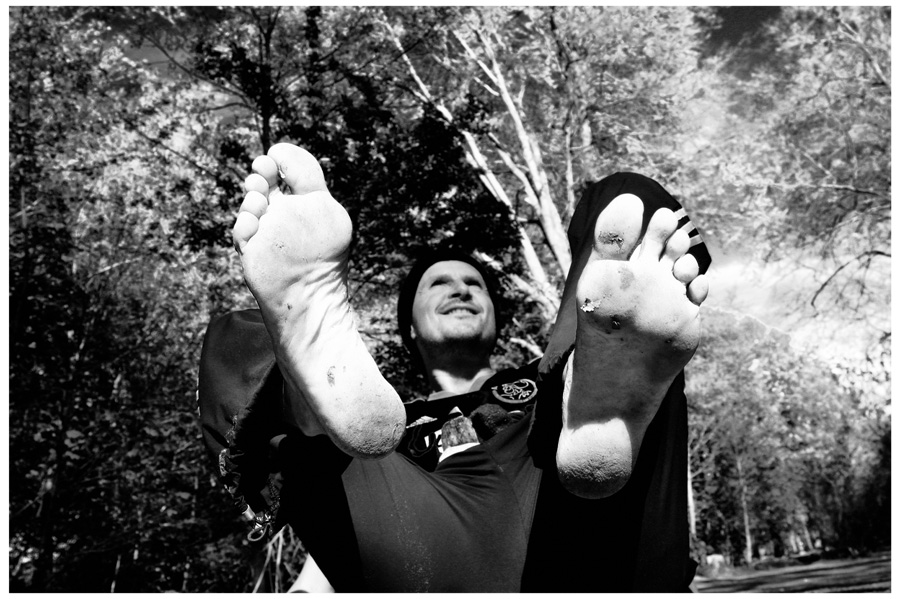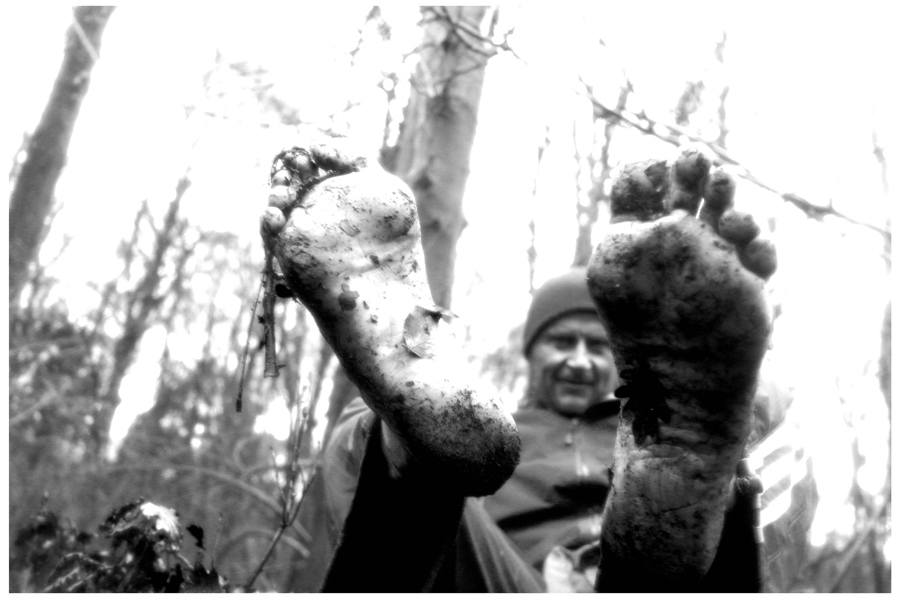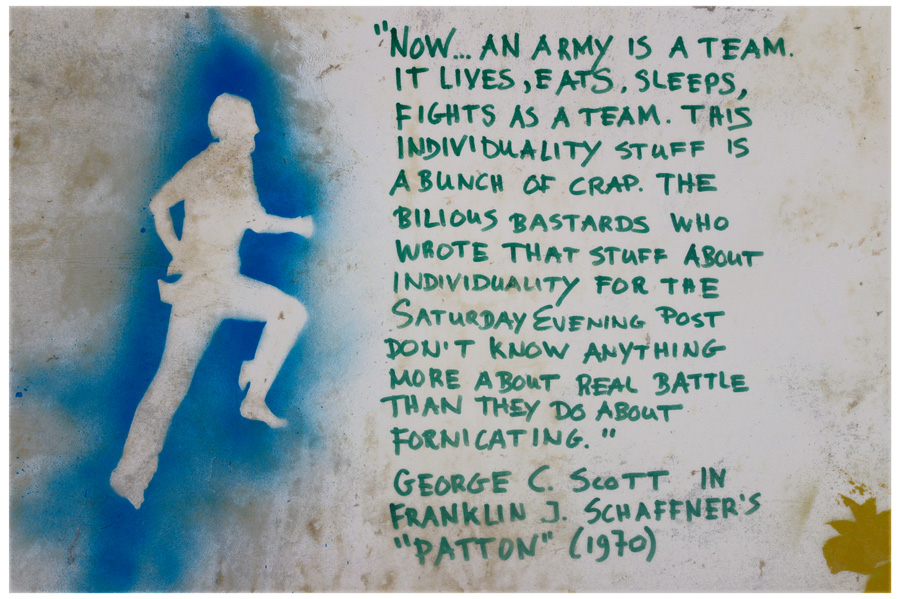SAR_act_3.3
- Details
- Hits: 7363

Above: FP 30K SAR BLT. SAR [ act 3.3 ] : director. When you aim your camera at a subject, the results start to speak beyond words available at the time of the making! This is my experience both with motion-picture and still-photography. Related to SAR [ Strategic Alert Running ] , I find it helpful to use a camera to picture the result of a training. It shows aspects that you may need to become aware of, as part of working on improvement of technique and efficiency. I would call it Photo Generated Injury Analysis, or PGIA.
SAR_11_dirt_dive
- Details
- Hits: 7325

Above: 30K SAR footprint
"Get in...get it over with...then get out"
'The Ballad of Cable Hogue' (1970) -- directed by Sam Peckinpah
As suggested in the previous post, best level is achieved when intensity and frequency are balanced.
Balanced frequency and intensity lead to progression and growth and fun.
See also:
http://bartvanbroekhoven.com/en-US/running/77-sar-10-threshold
Dirty Laundry
- Details
- Hits: 7171

Fight for the right to party.
Products above: Cannondale by Bikers (thank you John for the rear-wheel), Busenitz shoes by Adidas, trousers by H&M, T shirt by second-hand store Noppes. Photographed in our back garden, this morning.
Being 'up-to-speed' gives a sense of tremendous latitude. When winter-training starts (in the summer) the feeling is 'pretty bad'. Out of shape. Easily exhausted and out of breath. By building it up, we develop gradually (the summer is an excellent time for that). As a result, by the time it gets colder, our breath lasts longer and the space opens up with excellent training possibilities -- which we are able to reach and catch. Trough control over our breathing. And an awareness of our heart beating. Deep breath; as long as we are able to keep finding that, under the most severe training-conditions, then we're doing good.
Thank you Marion, Jack, Jacky and Flint for the kindhearted, gentle hospitality in your Italian beach-restaurant "Azzurro" in Zandvoort this summer.
Have a great winter.
Training/footprint/today_sunday/wild_wind_and_beach/wide_tide/32K/smooth_ride
- Details
- Hits: 7231

Fridays training preluded on this (todays-) one. 1) Properly dressed for the occasion this time; 2) Strategically navigating landscape and weather for maximum results. Excellent training-experience, full of opportunity: grab/praise/gratitude/thank-you-day! Strong wind from the South, sweeping low-tide-sea over flat beach -- creating awesome training conditions. Distance: 32K under richly varied circumstances.
Back to earth: Todays training inspired by coach Mark Divine's last blog:
"Training the fundamentals will allow you to build a foundation to move faster and go deeper into the training. Without the foundation, you could veer off track and get unbalanced, or fall off altogether out of frustration. This stage can take as long as you need and will depend upon your level of skill and time restraints when you start—some of my students spend just a few weeks getting up to speed on the basics while others take up to a year. Embrace your process and enjoy learning the new skills."
Read full post 'Slow is Smooth, Smooth is Fast'
SAR_sarsential™_15_authenticity
- Details
- Hits: 7146

Sarsential 15: authenticity [ unified identities on integral experience of growth: personal, as a family, group or team, and tribal, within a neighbourhood, company or society ]
Why train Strategic Alert Running? To support clearity and unity on all levels: shared vision (common, mutual understanding, reliability and trust at foundation), shared performance (looking out after teammates) and love and respect for people's uniqueness within the collective while expanding together.
"Representational pictures were the first true “medium” our ancestors created, some 30,000-40,000 years ago. Some of the early pictures were accurate depictions of the natural world. Others likely had a persuasive, even political, intent as they employed deliberate factual distortions. Understanding this human factor is crucial in understanding pictures. Any estimation of the meaning or effects of a picture must take into account the receptivity, attitudes, and beliefs of audiences, as well as those of producers or disseminators. [...] One popular myth is that pictures do not lie, and further that they have a fixed meaning. [T] he audience context confounds such a simplistic cause-and-effect scenario. [...] One man's atrocity photo may be another man's trophy snapshot. [...] People interpret what they see trough the prism of a media climate that discourse elites, such as journalists and political leaders, shape to serve their own interests. Humans, conditioned from infancy to favour seeing over our other senses, ascribe generally to the notion that "what we see is what we get". [...] The human mind has almost infinite capacities to ignore the truth when it wants to do so. [...] Information processing models within cognitive theory of mind in psychology suggest that what we see develops meaning in the context of what we have seen before and what we have stored in our long-term memory. Much of what we think about when we see a picture stems from our subjectivity and guides our interpretation. [H] umanization may not be as powerful as some think when it resides in the photo icon. Human beings have remarkable abilities to ignore the suffering of those whom they do not like. [...] To study the image, we must study the world from which the image originates and the world that the viewer encounters."
Natalia Mielczarek and David D. Perlmutter in 'VISUAL PROPAGANDA AND EXTREMISM IN THE ONLINE ENVIRONMENT', edited by Carol K. Winkler and Cori E. Dauber, chapter 9, page 215, 219, 220, 221, 228, 229, first published in USA, Juli 2014 by Strategic Studies Institute and U.S. Army War College Press
"The English peel off the unessentials of modernity very easily -- they 'go native' more readily than any Europeans except the Italians; and the more refined their upbringing the quicker the change comes about.": http://bartvanbroekhoven.com/en-US/running/134-sar-sarsential-toolbox-10-14ad


